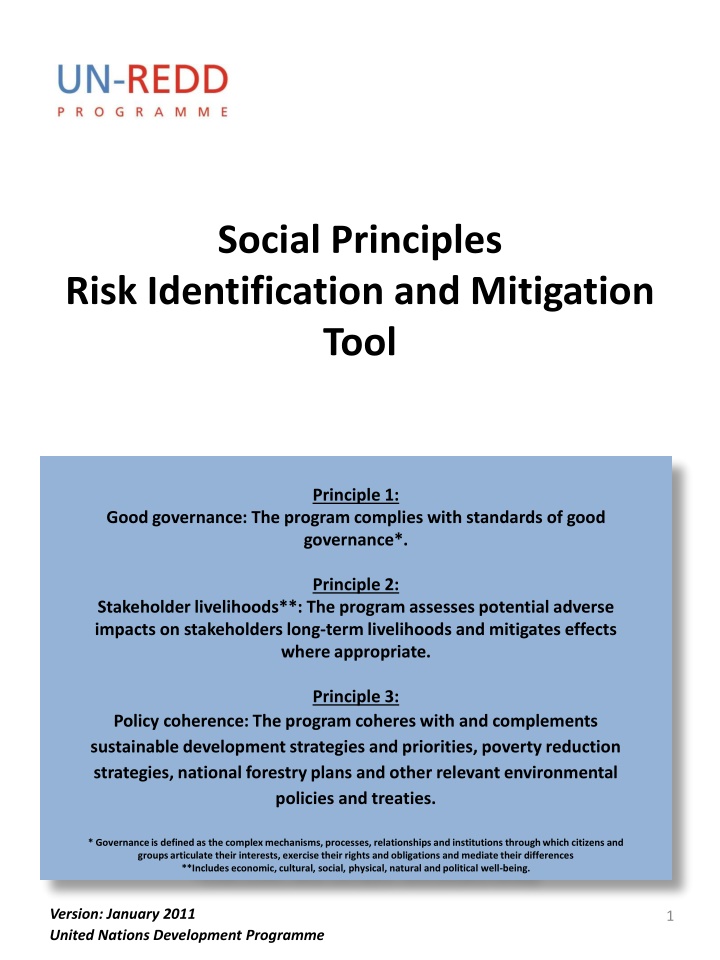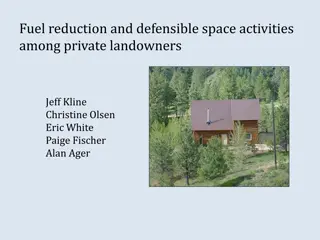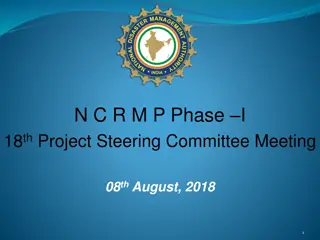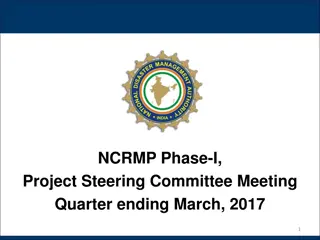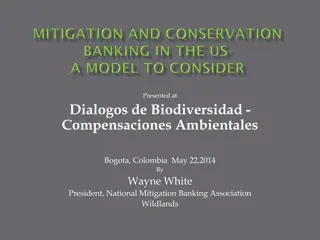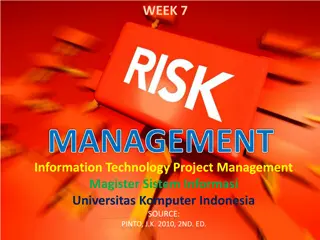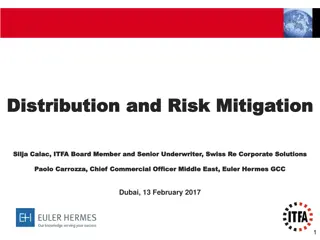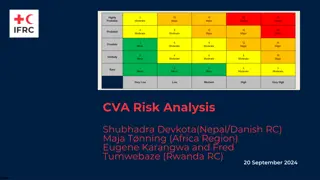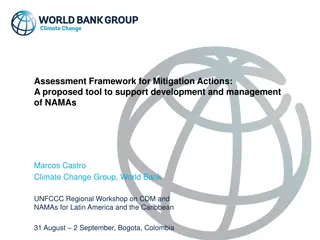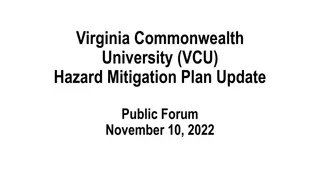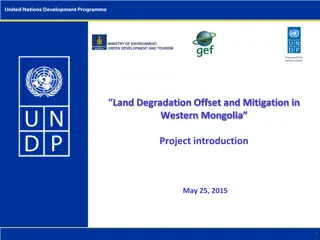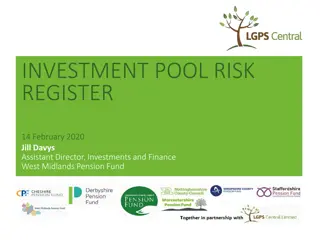Social Principles Risk Identification and Mitigation Tool Overview
This document outlines the principles and minimum social standards for risk identification and mitigation in programs, focusing on good governance, stakeholder livelihoods, and policy coherence. It provides criteria for assessing risks, including policy risks and actions for mitigation at different levels. The tool aims to guide users through identifying potential risks in their programs and taking appropriate mitigation measures.
Download Presentation

Please find below an Image/Link to download the presentation.
The content on the website is provided AS IS for your information and personal use only. It may not be sold, licensed, or shared on other websites without obtaining consent from the author.If you encounter any issues during the download, it is possible that the publisher has removed the file from their server.
You are allowed to download the files provided on this website for personal or commercial use, subject to the condition that they are used lawfully. All files are the property of their respective owners.
The content on the website is provided AS IS for your information and personal use only. It may not be sold, licensed, or shared on other websites without obtaining consent from the author.
E N D
Presentation Transcript
Social Principles Risk Identification and Mitigation Tool Principle 1: Good governance: The program complies with standards of good governance*. Principle 2: Stakeholder livelihoods**: The program assesses potential adverse impacts on stakeholders long-term livelihoods and mitigates effects where appropriate. Principle 3: Policy coherence: The program coheres with and complements sustainable development strategies and priorities, poverty reduction strategies, national forestry plans and other relevant environmental policies and treaties. * Governance is defined as the complex mechanisms, processes, relationships and institutions through which citizens and groups articulate their interests, exercise their rights and obligations and mediate their differences **Includes economic, cultural, social, physical, natural and political well-being. Version: January 2011 United Nations Development Programme 1
Minimum Social Standards - Principles and Criteria Principle 1 Good governance: The programme complies with standards of good governance. Criterion 1 Integrity of Fiduciary and Fund Management Systems The programme has assessed and addressed corruption and fiduciary risks Criterion 2 Transparency and Accountability Programme administration and REDD+ readiness activities are carried out in an accountable and transparent manner. a) All relevant stakeholders are identified and enabled to participate in a meaningful and effective manner; b) Special attention is given to most vulnerable groups and the free, prior and informed consent of indigenous peoples. Criterion 3 Stakeholder participation Programme planning and REDD+ readiness activities are carried out with attention to different gender roles and the empowerment of women. Criterion 4 Gender Equality Principle 2 Stakeholder livelihoods: The programme assesses potential adverse impacts on stakeholders long-term livelihoods and mitigates effects where appropriate. Criterion 5 Avoidance of involuntary resettlement The programme is not involved and not complicit in involuntary resettlement. The programme is not involved and not complicit in alteration, damage or removal of any critical cultural heritage or the erosion of traditional knowledge. . Criterion 6 Traditional Knowledge Criterion 7 Social and political well-being Social and political implications are assessed and adverse impacts on social and political structures mitigated. Benefits are shared equitably. Principle 3 Policy coherence: The programme coheres with and complements sustainable development strategies and priorities, poverty reduction strategies, national forestry plans and other relevant environmental policies and treaties. Criterion 8 Low-Emission, Climate Resilience Development Coherence The programme coheres with relevant strategies and policies at all levels of government. Social principles risk screens should apply to programme components delivered by UN agencies, government counterparts, partners, contractors and other third parties Update whenever framework paper is revised! 2
Overview and instructions Overview and instructions Tool overview: This is a risk identification and mitigation tool. With the help of indicator questions that can be answered yes or no , users are guided through assessing the programme for potential risks. Identified risks are categorized as follows: Policy Risks: Risks identified at the policy level present potential strategic risks to the programme. Risk mitigation actions should be taken at the policy or strategic level to ensure enabling conditions for the programme formulation and implementation. Policy Risks: Risks identified at the policy level present potential strategic risks to the programmeme. Risk mitigation actions should be taken during programme scoping and formulation. Programmatic Risks: Risks identified at the programme level present potential risks to programme design. Risk mitigation actions should be taken during programme inception and implementation. Operational Risks: Risks identified at the operational level present potential risks to the operation of the programme. Risk mitigation actions should be taken during programme implementation. Operational Risks: Risks identified at the operational level present potential risks to the operation of the programme. Risk mitigation actions should be taken to put in place appropriate operational procedures and mechanisms. Programmatic Risks: Risks identified at the programme level present potential risks to programme design. Risk mitigation actions should be taken to allow for necessary structural improvement(s) to be made in the programme. For reasons of simplified presentation, the tool includes a yes/no decision tree for each criterion and leads through a series of risk identification questions. However, rather than stopping when a risk is identified, the assessment should be continued and identified risk mitigation actions should be collected into a report based on Risk Mitigation Action Plan guidelines (currently being developed). Dark/light shading: The tool is designed to complement the REDD+ readiness process: Dark-shaded risk identification questions are general questions that can be answered at low or no costs because they do not require the consulting of further sources. They are intended to be addressed in early stages of the readiness process. Light-shaded risk identification questions can be addressed during implementation of UN-REDD national programmes or in later phases of readiness since they may require further consultation of sources or additional documentation. In particular, suggested risk mitigation strategies can only be assessed in later phases of readiness. Iterative application: Rather than a rigid one-time assessment, the tool should be applied to a different extent and iteratively throughout readiness design, implementation and monitoring. Ideally, policy risks identified early in the process will be addressed so as to facilitate the mitigation of related program and operational risks. As such, all identified risks should be interpreted as an opportunity to make the programme more effective and sustainable and does not imply that the programme cannot be designed in a rigorous, low-risk manner. Additional guidance: There is no one tool fits all approach since programmes may include a large range of activities. It will therefore be necessary to add further social due diligence considerations! Also, where risk areas are identified that cannot be sufficiently mitigated, the tool should be used in conjunction with other standards and best guidance for addressing these particular risk areas. Most importantly: The tool isdesigned to provide a standardized structure for thinking through and assessing a complex and multi-dimensional problem and enable consistent decision-making. It is not a standardized decision-making tool and does not replace good judgment! 3
Principle 1 Good governance Criterion 1 Integrity of fiduciary and fund management systems The programme has assessed and addressed fiduciary and fund management risks in order to minimize corruption. Recommended Risk Mitigation Action: Has the government ratified the UN Convention against Corruption and/or other regional or international anti- corruption instruments [1]? Has the programme demonstrated how it will go beyond current national practice? NO NO Does the country have its own credible legislation in place enforcing this criterion? NO POLICY Anti-corruption strategy to be prepared (provide link to best practice) YES YES Does the country actively enforce the principles from these conventions? YES NO YES Has the programme analyzed corruption types, magnitude and points of occurrence and emerging corruption risks and demonstrated how it will overcome these challenges? YES YES YES NO Has the country been assessed to have a high level of perceived/ experienced corruption? Corruption risks and mitigation measures to be identified (provide link to best practice) PROGRAMME Is there a recent assessment of corruption in the country [2]? NO Is corruption known or likely to be common in the country s forestry and other natural resources sectors? NO NO YES Relevant national and/or local anti-corruption bodies and partnership strategies to be identified (provide link to potential resources) Are there transparent anti- corruption controls or similar programmes for the forestry and natural resources sectors offered in the country? Has the programme established plans to work with national or local anti-corruption bodies (footnote : e.g. anti corruption commissions of or anti corruption units within other relevant institutions) NO NO YES Will the programme participate in such anti-corruption controls? NO YES YES Appropriate process to be followed / measures to be in place in accordance with UN standards (with link to standards) OPERATION Does the programme apply the accepted United Nations process for fund management and dispersal (eg. Harmonized Approach to Cash Transfers (HACT)) to the use of all UN-REDD funds [3]? NO Will any UN-REDD funds be transferred to implementing partners before a micro- assessment is undertaken and assurance measures are in place [3]? YES NO YES Appropriate result-based management measures to be applied in accordance with RBM Guidelines (provide link) Does the programme have a results-based monitoring and reporting system? NO NO Do all UN-REDD agencies apply the same cash transfer modality [3]? YES YES The Programme has assessed and addressed fiduciary and fund management risks, implementing anti-corruption measures where identified.
Principle 1 Good governance Criterion 2 - Transparency and Accountability: Programme administration and REDD+ readiness activities are carried out in an accountable and transparent manner. Recommended Risk Mitigation Action: Appropriate justification to be provided (link to policy) If not, does the programme clearly justify why disclosure practice differs? NO NO Does the programme disclose information to rights holders and stakeholders in accordance with UN-REDD policies? [1] YES All programme actors and their responsibilities to be clearly identified NO NO NO Are all decision- makers and programme actors within these institutions identified and held accountable for their actions [1]? Are all public and private institutions that are involved in programme design, implementation, administration and monitoring identified ? PROGRAMME YES YES YES Is there a recent national multi- stakeholder governance assessment for REDD+ [2]? Governance risk assessment to be undertaken (link to best practice) NO NO NO Does the national government commit to recognize and build upon the results of the assessment? YES Is there a recent third-party governance assessment recognized in the country? YES Are reliable channels for dissemination of information to stakeholders and the general public established [3]? YES NO Appropriate mechanisms to be placed (link to best practice/resou ces) Is accurate and comprehensive information available in a format that is accessible for all relevant stakeholders in a timely manner to enable participation[4]? YES NO Does the programme affect, establish or allocate land or property or user rights? YES Has the programme established a transparent establishment/allocation mechanism? NO OPERATION YES NO Necessary mechanisms /processes to be established in accordance with UN-REDD policies (link to guidance) YES Does the programme involve the distribution of REDD+ benefits? Has the programme established a transparent benefit distribution mechanism? NO YES NO YES Are appropriate processes in place for stakeholders to provide feedback on the distribution of benefits from REDD+ ? Necessary mechanisms /processes to be established in accordance with UN-REDD policies (lnk to guidance) YES NO Does the programme incorporate an accessible, impartial and transparent mechanism to resolve disputes under this criterion? NO YES The Programme has demonstrated an acceptable level of accountability and transparency, improving practices where risks are identified.
Principle 1 Good governance Criterion 3 Stakeholder participation[1]: a) All relevant stakeholders are identified and enabled to participate in a meaningful and effective manner. Recommended Risk Mitigation Action : NO Stakeholders and their interests should be identified and documented (link to list of stakeholders) Stakeholder rights, land and resource claims should be documented (link to best practice) Programme should include process for maintaining impartial and equitable distribution of benefits (link to guidance) Have all relevant groups of stakeholders been identified [2]? YES NO Have stakeholder interests been identified and documented? YES Have rights (statutory and customary) to land, territories and resources been documented comprehensively? PROGRAMME NO YES NO Have reliable maps been established for affected forest areas? YES Have (potentially) overlapping claims for land or resources been identified? NO YES NO Does the programme outline how carbon rights and other benefits are distributed impartially? YES NO Has the programme demonstrated that it will not impact decisions in dispute situations? YES Programme must follow the Operational Guidance on the Engagement of Indigenous Peoples and other Forest Dependent Communities (link) Programme must follow the Operational Guidance on the Engagement of Indigenous Peoples and other Forest Dependent Communities (link) NO Have all relevant stakeholder groups been actively invited to engage in a timely manner and in appropriate format/language? YES Do representatives have authority to represent stakeholder groups and can be held accountable by them[3]? NO YES Are representatives able to report all relevant information accurately back to stakeholder groups in a timely manner to seek their feedback? YES NO OPERATION NO Are stakeholders meaningfully involved in designing the stakeholder participation process and mechanism? YES Have potential positive and negative impacts been communicated comprehensively to corresponding stakeholders? YES NO Do stakeholders have access to additional external and independent expertise including legal advice? NO YES Are stakeholders regularly, timely , free of costs, accurately and in appropriate format/language informed about program updates? YES NO Programme should include an accessible and impartial recourse mechanism (link to guidance) Are consultations and received feedback documented in a comprehensive and consistent manner and made available for further review by stakeholders? NO YES NO Does the programme incorporate an accessible, transparent and impartial grievance mechanism for all stakeholders? YES The Programme has effectively engaged all relevant stakeholders, in accordance with UN-REDD Programme guidelines.
Principle 1 Good governance Criterion 3 Stakeholder participation[1]: b) Special attention is given to the poor and most vulnerable groups and the free, prior and informed consent of indigenous peoples. Recommended Risk Mitigation Action : Programme demonstrate how it will go beyond current national practice (link to best practice) NO Did the country vote in favor of or endorse the UN Declaration on the rights of indigenous people [4]? NO Has the programme analyzed reasons for lack of support and demonstrated how it will overcome areas of country-specific concerns? YES POLICY Indigenous peoples rights and territories should be documented (link to treaties) Has the country ratified the ILO Convention 169 (Indigenous and Tribal Populations Convention) [5]? NO NO YES Does the country have effective and active legislation in place that reflects the commitments made through these treaties? YES National commitments to respect indigenous peoples rights should be documented (link to UNDRIP) Programme should include arrangements to protect the rights of indigenous peoples living in isolation (link to best practice) Indigenous peoples rights and territories should be documented (link to best practice) NO Will the programme impact the rights of indigenous peoples to their traditional lands, territories, resources or livelihoods? YES PROGRAMME NO Does the program provide comprehensive documentation identifying affected indigenous peoples and other forest dependent communities? YES NO YES Are measures taken to protect these groups rights even in absence of direct consultation? Are some indigenous people living in voluntary isolation? NO YES Have interest and rights (both statutory and customary) of indigenous peoples and other forest dependent communities and potential impacts of REDD programmes been thoroughly analyzed and communicated to these groups? NO Are existing local institutions, processes, networks and authorities leveraged to engage indigenous peoples and other vulnerable groups? YES NO YES Programme must follow the Operational Guidance on the Engagement of Indigenous Peoples and other Forest Dependent Communities (link to guidance) NO Are consultations conducted and information disseminated in a culturally appropriate manner and sufficiently timely to allow for effective participation? YES OPERATION YES NO Are clear objectives for consultations laid out including indicators for success/results? Will the programme undertake a consultative process to seek the free, prior and informed consent of indigenous peoples and other forest dependent communities that may be impacted by the programme? [6] YES NO Are mechanisms for dispute resolution established and consequences and procedures defined for cases where consent is not given or the community s decision is not respected? YES Programme should include an accessible and impartial recourse mechanism (link to guidance) NO Will there be external/independent verification of stakeholder engagement processes? YES NO The Programme has effectively engaged the poor and most vulnurable group and has sought the free, prior and informed consent of indigenous peoples, where necessary.
Principle 1 Good governance Criterion 4 Gender Equality: Recommended Risk Mitigation Action: Program planning and REDD+ readiness activities are carried out with attention to different gender roles and women s empowerment. National commitments to promote gender equality should be documented (link to CEDAW) should demonstrate how it will go beyond current national practice (link to best practice) Does the country have its own legislation in place to end discrimination against women and promote gender equality? NO YES POLICY Has the government ratified CEDAW? YES NO Programme NO Has the programme demonstrated how it will go beyond current national practice? YES Programme should consider gender in its analysis of the drivers of deforestation (link to best practice) NO Has the program taken gender into account in its analysis of the drivers of deforestation ? YES Stakeholder participation processes should equitably involve both men and women (link to best practice) Has the program actively sought the equal participation of both genders in stakeholder consultation processes? NO PROGRAMME YES Programme readiness activities should reflect gender roles of key actors (link to best practice) Have readiness activities been planned taking into account the different roles of men and women in forest management, community and household decision making? NO YES OPERATION Are benefits from the program distributed in a way that does not exacerbate existing gender inequality and supports women s empowerment? Programme should implement gender sensitive benefit distribution practices (link to guidance) NO YES The Programme takes into account gender considerations, in support of gender equality and women s empowerment.
Principle 2 Stakeholder livelihoods Criterion 5 Avoidance of involuntary resettlement: The programme is not involved and not complicit in involuntary resettlement. Recommended Risk Mitigation Action: National commitments to respect indigenous peoples rights should be documented (link to treaties) Programme demonstrate how it will go beyond current national practice (link to best practice) NO YES POLICY Does the country have its own legislation in place prohibiting involuntary resettlement? Has the government ratified the ILO convention 169 [1]? YES NO NO Has the programme demonstrated how it will go beyond current national practice? YES YES Is any resettlement envisaged by the programme ? Programme must follow the Operational Guidance on the Engagement of Indigenous Peoples and other Forest Dependent Communities (link to guidance) NO Can the programme demonstrate that where any relocation or displacement, whether physical or economic, occurs in accordance with free, prior and informed consent, there is prior agreement on the provision of alternative lands and/or fair compensation, and the right to return once the reasons for the displacement have ceased? NO YES PROGRAMME Stakeholder rights, land and resource claims should be documented (link to best practice) Are there communities/individuals with statutory and/or customary rights to forest land and/or resources relevant to the programme ? NO YES Programme should include an accessible and impartial recourse mechanism (link to guidance) OPERATION NO Is a mechanism in place to receive and resolve grievances and disputes effectively relating to resettlement? The Programme is not involved in involuntary resettlement and is in accordance with UN-REDD Programme guidelines.
Principle 2 Stakeholder livelihoods Criterion 6 Traditional Knowledge: The programme is not involved and not complicit in alteration, damage or removal of any critical cultural heritage or the erosion of traditional knowledge. Recommended Risk Mitigation Action: National commitments to respect cultural heritage and traditional knowledge should be documented (link to treaties) Programme should demonstrate how it will go beyond current national practice (link to best practice) POLICY NO YES Has the country signed/ratified or adopted relevant international treaties, conventions and/or other instruments and enforces them [1]? Does the country have its own legislation in place protecting traditional knowledge and/or cultural heritage? NO YES Has the programme demonstrated how it will go beyond current national practice? NO YES Programme should demonstrate how it will comply with relevant legal instruments (link to treaties) Are any possible areas where the programme does not, or may not, comply with the relevant local and national laws and international treaties, conventions and other instruments identified and monitored? YES NO PROGRAMME Stakeholder rights, land and resource claims should be documented (link to best practice) Does the programme include any MRV and/or monitoring activities, that could affect traditional usufruct rights? NO YES OPERATION Programme should include an accessible and impartial recourse mechanism (link to guidance) NO Is a mechanism in place to receive and resolve grievances and disputes effectively relating to traditional knowledge? YES The Programme has assessed risks to traditional knowledge and cultural heritage, undertaking mitigation actions where risks are identified.
UN REDD Principle 2: Stakeholder livelihood Principle 2 Stakeholder livelihoods Criterion 7 Social and political well-being: Social and political implications are assessed and adverse impacts on social and political structures mitigated. Benefits are shared equitably. [1] Recommended Risk Mitigation Action: NO NO Has the programme demonstrated how it will go beyond current national practice? Has the country signed/ratified or adopted relevant international treaties, conventions and/or other instruments [2]? Does the country have its own credible legislation in place enforcing this criterion? POLICY Appropriate measures to be introduced (link to treaties) YES YES YES NO Are there possible areas where the design and/or implementation of the programme does not, or may not, comply with the relevant local and national laws and international treaties, conventions and/or other instruments? YES NO Is there a participatory process to assess how programme activities might impact social and political structures and in particular how empowerment of most vulnerable groups might be impacted? NO Is there an participatory assessment of positive and negative social, cultural, human rights and political impacts of the REDD+ programme for Indigenous Peoples and local communities including both predicted and actual impacts [3]? YES Appropriate justification to be provided (link to best practice) NO Appropriate assessment to be conducted (link to guidance) YES Will the risks of negative impacts on social and political well- being be reviewed throughout the programme cycle? PROGRAMME YES Are any of the intended impacts of the programme expected to be negative? YES NO NO Have social and political drivers of deforestation been analyzed and does the programme address the underlying interests of stakeholders? YES Are there transparent, participatory, effective and efficient mechanisms for establishing equitable sharing of benefits of the REDD+ programme among and within relevant rights holder and stakeholder groups taking into account costs, benefits and associated risks? YES NO Appropriate analyses to be carried out (link to best practice) NO Does the programme identify and use a process for effective resolution of any disputes over rights to lands, territories and resources related to the programme? NO OPERATION NO Is a mechanism in place to receive and resolve grievances and disputes effectively relating to the distribution of benefits? Appropriate mechanisms /processes to be established in accordance with Operational Guidance (link to guidance) YES YES Is there is full and effective participation of relevant rights holders and stakeholders that want to be involved, including the marginalized and/or vulnerable people among them, in defining the decision-making process and the distribution mechanism for equitable benefit-sharing among and within relevant rights holders and stakeholder groups? NO YES The Programme has assessed risks to social and political well-being , undertaking mitigation actions where risks are identified.
UN REDD Principle 2: Stakeholder livelihood Principle 3 Policy Coherence Criterion 8 Low Emission, Climate Resilient Development Coherence Economic implications are assessed and adverse impacts are mitigated except for where they are intended. Recommended Risk Mitigation Action: POLICY Appropriate assessment /estimation to be completed (link to best practice) Is there an detailed assessment of the GHG abatement potential of REDD+ in the country? NO YES NO Appropriate estimation to be completed (link to best practice) NO YES Have the potential economic costs of implementing REDD+ been estimated for the country[1]? Has a cost curve been estimated for REDD+ in the country at different CO2e prices? YES Will the estimated costs be more than the potential benefits? Appropriate strategic adjustments to be made (link to best practice) Appropriate strategic integration process to be completed (link to best practice) NO YES Does the programme elaborate how its policies and measures will contribute to the implementation of existing sustainable development and poverty reduction policies, strategies and plans developed at national and other relevant levels? NO PROGRAMME NO YES Is there a regular and ongoing multi- sectoral process involving national planning and other relevant bodies of governments/institut ions/divisions to implement the strategy? Is the national REDD+ strategy part of a low-emission, climate resilient development strategy? Appropriate multi-sectoral mechanism(s) to be established in a nationally acceptable manner (link to best practice) YES NO Is there an assessment of the likely impact of implementing REDD+ on job creation and off-farm rural livelihoods? YES Appropriate assessment to be conducted (link to best practice) NO Are stakeholders provided access to alternative livelihoods? Appropriate options to be assessed and presented (link to best practice) NO YES The Programme coheres with national strategies, policies and plans, undertaking supportive measures where risks to policy coherence are identified.
UN REDD Principle 2: Stakeholder livelihood Annex Criterion 1 Integrity of Fiduciary and Fund Management Systems [1] Status of ratification can be found at http://www.unodc.org/unodc/en/treaties/CAC/signatories.html. [Need to add in references for appropriate regional instruments] [2] [Need to add examples of possible assessments, potentially such as http://www.transparency.org/policy_research/surveys_indices/cpi/2009/cpi_2009_table ] [3] See http://www.undg.org/index.cfm?P=255 for more information concerning the HACT Criterion 2 Transparency and Accountability [1] UN-REDD Programme Information Disclosure Policy will be presented to the Policy Board during the November 2010 meeting. Once approved, the Policy will be available for download at www.un-redd.org [2] National multi-stakeholder governance assessment for REDD+ are modeled on UNDP s Country-led Governance Assessments . See http://www.unredd.net/index.php?option=com_docman&task=doc_download&gid=1296&Itemid=53 for more details. [3] Reliablechannels also refers to assigning clear responsibility for information dissemination to one or more appropriate persons and to identifying appropriate forums for information dissemination (websites, expert groups, etc.). [4] Accessibility of information refers in particular to language (i.e. local language necessary for example for indigenous peoples and English for international community) and medium (e.g. online, via mail, stakeholder meetings, expert forums, radio where high rate of illiteracy etc.) Criterion 3 Stakeholder participation* [1] See the UN-REDD programmeme Operational Guidance on the Engagement of Indigenous Peoples and other Forest Dependent Communities: http://www.unredd.net/index.php?option=com_docman&task=doc_download&gid=455&Itemid=53. [2] Stakeholder refers to a person or group of persons that can affect or may be affected by the programme. In the context of REDD, stakeholder include in particular the following groups: Forest dwellers including both persons/communities with statutory and with customary rights to land, territories and forest products/services, including indigenous peoples and local communities. Forest-dependent persons and communities including those that depend on upstream/downstream industries (e.g. wood working and transporting industry) and consumers of essential forest goods and services (in particular fuelwood and agricultural products) and who might be impacted by price changes, including indigenous peoples and local communities. programme developers and employees as well as contractors and supplying companies or organizations All levels of government in the country Civil society in the country and internationally UN-REDD Programme representatives Note that stakeholders may live in REDD-targeted forest areas but also outside these areas and even outside the national boundary (in particular stakeholders that might be impacted by price changes for fuelwood). [3] Note that representative might not necessarily be form within the group For example, a (male) lawyer might represent a group of indigenous women. This is in line with the criterion as long as it was an informed and free selection and as long as the representative can be fully held accountable by the group. 13
UN REDD Principle 2: Stakeholder livelihood Annex Criterion 3 Stakeholder participation (continued) [4] The Declaration on the Rights of Indigenous Peoples (document A/61/L.67) was adopted by a recorded vote of 143 in favour to 4 against, with 11 abstentions, as follows: In favour: Afghanistan, Albania, Algeria, Andorra, Angola, Antigua and Barbuda, Argentina, Armenia, Austria, Bahamas, Bahrain, Barbados, Belarus, Belgium, Belize, Benin, Bolivia, Bosnia and Herzegovina, Botswana, Brazil, Brunei Darussalam, Bulgaria, Burkina Faso, Cambodia, Cameroon, Cape Verde, Central African Republic, Chile, China, Comoros, Congo, Costa Rica, Croatia, Cuba, Cyprus, Czech Republic, Democratic People s Republic of Korea, Democratic Republic of the Congo, Denmark, Djibouti, Dominica, Dominican Republic, Ecuador, Egypt, El Salvador, Estonia, Finland, France, Gabon, Germany, Ghana, Greece, Guatemala, Guinea, Guyana, Haiti, Honduras, Hungary, Iceland, India, Indonesia, Iran, Iraq, Ireland, Italy, Jamaica, Japan, Jordan, Kazakhstan, Kuwait, Lao People s Democratic Republic, Latvia, Lebanon, Lesotho, Liberia, Libya, Liechtenstein, Lithuania, Luxembourg, Madagascar, Malawi, Malaysia, Maldives, Mali, Malta, Mauritius, Mexico, Micronesia (Federated States of), Moldova, Monaco, Mongolia, Mozambique, Myanmar, Namibia, Nepal, Netherlands, Nicaragua, Niger, Norway, Oman, Pakistan, Panama, Paraguay, Peru, Philippines, Poland, Portugal, Qatar, Republic of Korea, Saint Lucia, Saint Vincent and the Grenadines, San Marino, Saudi Arabia, Senegal, Serbia, Sierra Leone, Singapore, Slovakia, Slovenia, South Africa, Spain, Sri Lanka, Sudan, Suriname, Swaziland, Sweden, Switzerland, Syria, Thailand, The former Yugoslav Republic of Macedonia, Timor-Leste, Trinidad and Tobago, Tunisia, Turkey, United Arab Emirates, United Kingdom, United Republic of Tanzania, Uruguay, Venezuela, Viet Nam, Yemen, Zambia, Zimbabwe. Against: Australia (endorsed later), Canada, New Zealand, United States. Abstain: Azerbaijan, Bangladesh, Bhutan, Burundi, Colombia (endorsed later), Georgia, Kenya, Nigeria, Russian Federation, Samoa (endorsed later), Ukraine. Absent: Chad, C te d Ivoire, Equatorial Guinea, Eritrea, Ethiopia, Fiji, Gambia, Grenada, Guinea-Bissau, Israel, Kiribati, Kyrgyzstan, Marshall Islands, Mauritania, Montenegro, Morocco, Nauru, Palau, Papua New Guinea, Romania, Rwanda, Saint Kitts and Nevis, Sao Tome and Principe, Seychelles, Solomon Islands, Somalia, Tajikistan, Togo, Tonga, Turkmenistan, Tuvalu, Uganda, Uzbekistan, Vanuatu. [6] Ratification status can be checked at http://www.ilo.org/ilolex/cgi-lex/ratifce.pl?C169 . [7] The Report of the International Workshop on Methodologies Regarding Free Prior and Informed Consent E/C.19/2005/3, endorsed by the UNPFII at its Fourth Session in 2005, defines the elements as follows: Free should imply no coercion, intimidation or manipulation; Prior should imply consent has been sought sufficiently in advance of any authorization or commencement of activities and respect time requirements of indigenous consultation/consensus processes; Informed should imply that information is provided that covers (at least) the following aspects: a. The nature, size, pace, reversibility and scope of any proposed project or activity; b. The reason/s or purpose of the project and/or activity; c. The duration of the above; d. The locality of areas that will be affected; e. A preliminary assessment of the likely economic, social, cultural and environmental impact, including potential risks and fair and equitable benefit sharing in a context that respects the precautionary principle; f. Personnel likely to be involved in the execution of the proposed project (including Indigenous Peoples, private sector staff, research institutions, government employees and others) g. Procedures that the project may entail. Consent Consultation and participation are crucial components of a consent process. Consultation should be undertaken in good faith. The parties should establish a dialogue allowing them to find appropriate solutions in an atmosphere of mutual respect in good faith, and full and equitable participation. Consultation requires time and an effective system for communicating among interest holders. Indigenous Peoples should be able to participate through their own freely chosen representatives and customary or other institutions. The inclusion of a gender perspective and the participation of indigenous women is essential, as well as participation of children and youth as appropriate. This process may include the option of withholding consent. Consent to any agreement should be interpreted as Indigenous Peoples have reasonably understood it. 14
UN REDD Principle 2: Stakeholder livelihood Annex Criterion 4 Avoidance of involuntary resettlement [1] Ratification status can be checked at http://www.ilo.org/ilolex/cgi-lex/ratifce.pl?C169 . Criterion 5 Traditional Knowledge [1] Relevant conventions include in particular the UNESCO Convention concerning the Protection of the World Cultural and Natural Heritage (http://whc.unesco.org/en/conventiontext ) and the UNESCO Convention for the Safeguarding of the Intangible Cultural Heritage (http://portal.unesco.org/en/ev.php- URL_ID=17716&URL_DO=DO_TOPIC&URL_SECTION=201.html ). For ratification status, refer to http://portal.unesco.org/la/convention.asp?language=E&KO=13055 and http://portal.unesco.org/la/convention.asp?language=E&KO=17116&order=alpha. See table prepared by CIEL of relevant human rights conventions and treaties: http://www.unredd.net/index.php?option=com_docman&task=doc_download&gid=2327&Itemid=53 Criterion 6 Social and political well-being [1] Social well-being refers to an individual s or a group of individuals standing within the community, social networks and opportunities, social security etc. Political well-being refers to an individual s or a group of individuals empowerment and influence on decision- making within the community and beyond. It furthermore includes the freedom to express opinion without the fear of negative consequences. [2] Relevant treaties include in particular: International Covenant on Civil and Political Rights http://treaties.un.org/Pages/ViewDetails.aspx?src=TREATY&mtdsg_no=IV-4&chapter=4&lang=en International Convention on the Elimination of all forms of Racial Discrimination http://treaties.un.org/Pages/ViewDetails.aspx?src=TREATY&mtdsg_no=IV-2&chapter=4&lang=en Convention on the Elimination of All Forms of Discrimination Against Women http://treaties.un.org/Pages/ViewDetails.aspx?src=TREATY&mtdsg_no=IV-8&chapter=4&lang=en [3] For further explanation of appropriate participatory processes, see the UN-REDD programme Operational Guidance on the Engagement of Indigenous Peoples and other Forest Dependent Communities: http://www.unredd.net/index.php?option=com_docman&task=doc_download&gid=455&Itemid=53. Criterion 7 Low-Emission, Climate Resilient Development Coherence [1] will need to put in a note explaining what is meant by economic costs, including opportunity costs 15
